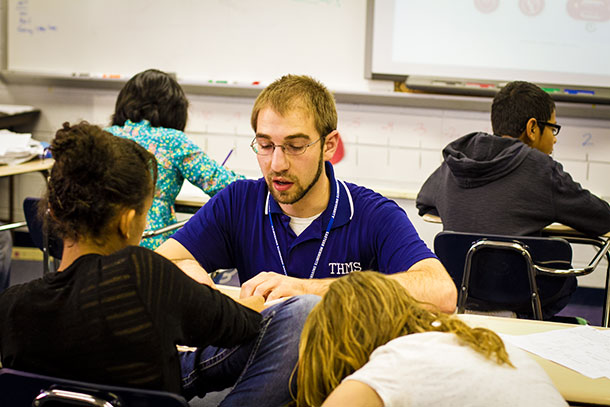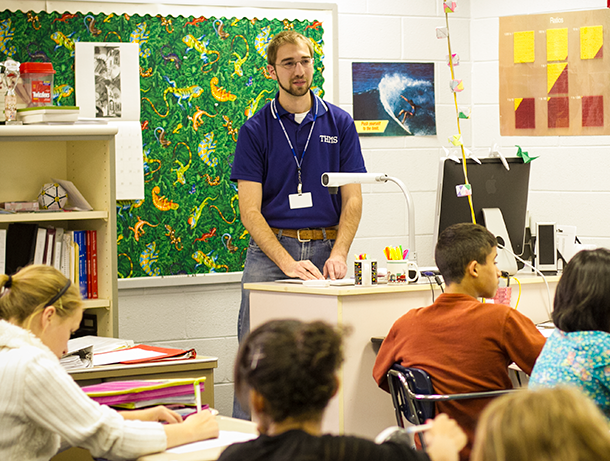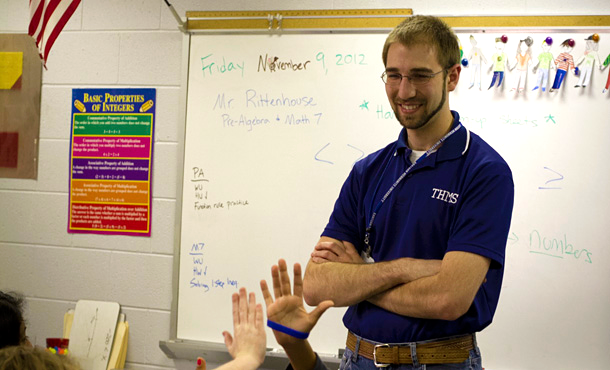Steven Rittenhouse ’11 recalls a student-teaching “aha!” moment – a turning point both for himself, then an Eastern Mennonite University (EMU) undergraduate, and for a boy who dropped into his classroom during a planning period at Thomas Harrison Middle School (THMS).
“He was visibly frustrated with his math homework. We worked with it together, and I helped him see he misunderstood just a small part of the assignment,” says Rittenhouse.
“Once he understood and felt much better, I encouraged him to go a little further by asking him if he wanted to create his own octagonal pyramid. He agreed, and we had a great time simply using some paper, a compass, and a ruler to create a completely hand-made octagonal pyramid that he could take home to show his parents.”
The boy’s pride in his work “secured for me the excitement I have for helping young minds succeed and have self-confidence,” adds Rittenhouse, now a math teacher at THMS.
Rittenhouse’s success has benefited from two characteristics of EMU’s teacher education program.
One involves sending future teachers into classrooms early. When he arrived at EMU in 2007 from Franconia, Pa., with no major selected, an advisor suggested he enroll in the “Exploring Teaching” course. It put Rittenhouse into a classroom during his first semester of college, allowing him to discover a vocation he loved.

Another characteristic is “reflective practice,” which Rittenhouse notes is woven into all the education classes at EMU.
“In my own classroom I am constantly reflecting on what just happened yesterday, the last class period, and even the last five minutes. Reflective practice allows me to be receptive to new ways of teaching and new ways of working with ever-changing middle school students.”
Education professor Lori Leaman ’88, whose influence Rittenhouse singles out, says that Steven proved to be “the type of teacher that EMU hopes to nurture and shape.”
Rittenhouse is equally complimentary of Leaman. Through role playing, she “empowered us as future teachers to experiment and practice in class.”
Leaman explains that role play, which she implemented for the “Needs of Diverse Learners” course, requires not only writing a lesson plan, but acting out the lesson with peers in each possible role. It allows a professor to “press the ‘pause’ button at a teachable moment to dissect what just happened, not only from an academic perspective, but from a relational perspective,” she says.

“Believe it or not, college students are not only up for the ‘risk’; they embrace it. Throughout the semester, as students rotate through the roles of teacher, general education student, student with a disability, and peer teacher, they make it a goal to reach all students, not just teach a subject.”
Leaman remembers watching Rittenhouse become “one of our exemplary reflective practitioners.”
He planned to teach high school until his third year at EMU, when a course in middle-school teaching “showed me a different side to middle school than my own experience,” with realization that was “where I should be.”
Hired at THMS following his 2011 graduation, he meets five groups of students daily for classes in Math 7, pre-algebra (which combines content for grades 7 and 8), and “math support” (for students needing extra help).
“My students come from many different backgrounds and family styles,” says Rittenhouse. “I have to think about differentiating a lesson” to meet their diverse needs, but the diversity is also “a blessing” because “I can learn many things from my students, and they can learn from me and each other.”
Rittenhouse, who has lived in Harrisonburg since entering EMU, also enjoys baking, photography, electronics, learning new languages, fish-keeping, time with friends, and family visits.
